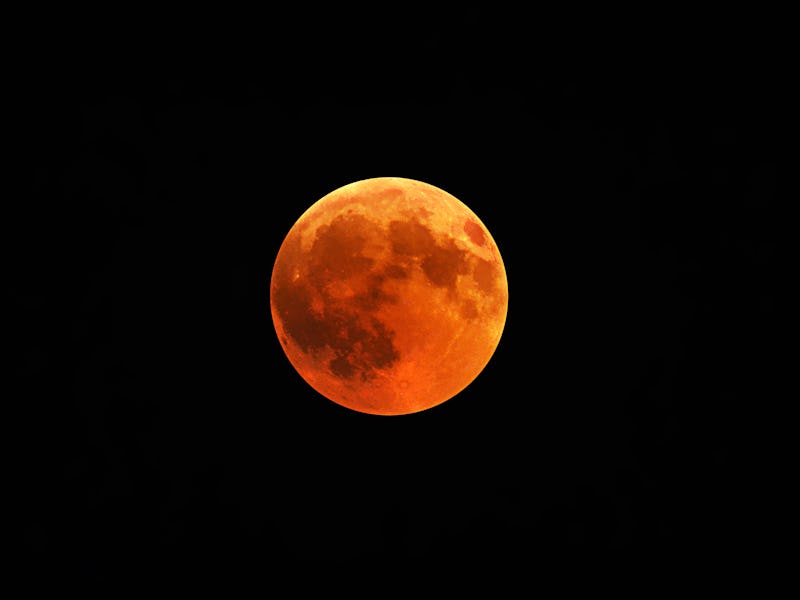You don't want to miss May's Super Flower Blood Moon Eclipse
A total lunar eclipse will grace our skies in the early hours of May 26.

The “Blood Moon” may be a great band name, but Edward Rhodes is quick to point out that it’s something cooler than that: it’s a lunar eclipse.
Rhodes, an astronomy professor at the University of Southern California, often concerns himself with all matters of the Sun by day. But he’s also got a keen interest in those conjunctions of the Sun, the Moon, and the Earth in various configurations that cause eclipses.
“People call it the Blood Moon, but that is not a scientific term,” Rhodes tells Inverse. “There's a scientific reason for why it looks reddish and that's because the atmosphere of the Earth bends some of the sunlight in just such an angle that the red wavelength illuminates the Moon’s surface.”
We’ve got a total lunar eclipse just around the corner, with a mouthful of a name: the Super Flower Blood Moon. Here’s what you need to know.
What is a Super Flower Blood Moon?
To break that name down:
- The Moon will be a Supermoon, which happens when a Full Moon coincides with the Moon’s closest approach to Earth that cycle. It may appear 7 percent bigger and 15 percent brighter than it normally looks from our view from Earth.
- A Flower Moon is the name for the Full Moon of May, a name given to it by Algonquin tribes, according to the Old Farmer’s Almanac, as it coincides with the time of the year where flowers bloom across North America.
- For observers in many parts of the world, the shadow of Earth will cross the moon and turn it red, giving it the “Blood Moon” part of the name.
So why does the Moon turn red? Sunlight passes through the Earth's atmosphere and gets refracted towards the Earth's surface. But part of the sunlight, the colors with shorter wavelengths, gets scattered while colors with longer wavelengths, like orange and red, pass through the atmosphere.
A NASA visualization of where the Total Lunar Eclipse will be visible.
When will the total lunar eclipse take place?
This is the first total lunar eclipse since January 2019.
The eclipse will take place just a few hours after the Moon reaches perigee, which is when the Moon reaches the closest point to Earth in its orbit. The eclipsed Moon will appear in the early morning hours before sunrise if you live in:
- western North America, around 1:47 a.m. Pacific time
- southern and far-western South America
- some islands in the Pacific Ocean
It will appear in the evening hours after sunset if you live in New Zealand, Australia, and Southeast Asia.
Partial eclipses may be visible in other areas. The Moon will also be a Super Moon, meaning that it will be the closest full moon of the year,
This is the second of two Supermoons this year; the first one took place on April 26.
According to NASA, “Visibility of the total phase in the contiguous U.S., at 11:11 UTC. Totality can be seen everywhere in the Pacific and Mountain time zones, along with Texas, Oklahoma, western Kansas, Hawaii, and Alaska.”
What is a total lunar eclipse?
A total lunar eclipse takes place when the Earth is wedged between the Sun and the Moon, obscuring the Sun’s light from Earth’s orbiting satellite, and therefore drenching it in darkness. For a total lunar eclipse to take place, the Sun, Earth, and the Moon align in a straight line for a brief moment.
Rhodes says every lunar eclipse is not total because the Moon's position is not the same relative to that central point of the Earth's shadow.
While this will be a total lunar eclipse, it will be a short one, with totality lasting just 15 minutes. Most eclipses in the 21st century spent several minutes — sometimes hours — in totality.
“This particular eclipse, the reason that the total phase is so brief is that the north edge of the Moon's disk is just skirting the inner edge of the inner portion of the Earth’s shadow,” Rhodes says.
That light then gets refracted towards the surface of the Moon, giving it that reddish color. The total lunar eclipse only takes place when it’s a Full Moon.
A NASA diagram showing what causes various kinds of lunar eclipses.
What is a supermoon?
A supermoon occurs when a Full Moon happens to be closest to the Earth during its orbit. The proper astronomical term for it is perigean full Moon— referring to the closest point in the moon’s orbit called a perigee. The term supermoon itself comes from astrology.
Last year saw four supermoons, with the last one being on May 7.
But this year, this is your last chance to catch the Moon during this phase as we only got two supermoons.
The next total lunar eclipse will take place in May 2022.
This article was originally published on